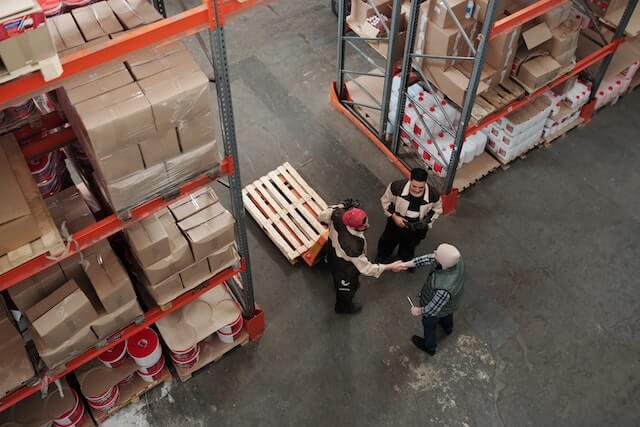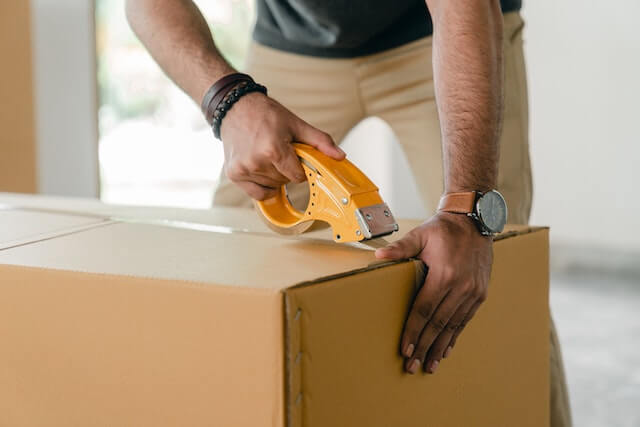When it comes to investigating new business ideas, it’s no surprise to find drop shipping on any listicle of best side-hustles. But what is drop shipping and can Australia be a good place to launch such a business?
As the 55th most populated country, Australia punches well above its weight as the 11th largest eCommerce market in the world.
Reselling products online is considered one of the easiest types of businesses to start. It differs from other businesses that sell products they’ve either found, made, upcycled or bought.
Drop shipping is a way of selling goods without ever having to handle them yourself. All you have to do is research and source out the best drop shipping products to sell — and then sell them.
What is drop shipping?
Drop shipping begins with someone making a purchase from you. Then, the product is shipped to them directly from your supplier.
You never have to deal with the headaches of shipping, storing or packing the products yourself.
By not worrying about supply chain logistics or inventory management, you can focus on finding the best drop shipping products for your target audience. Succeeding with this business model requires informing and connecting with buyers to spark wild demand.
Drop shipping is renowned for its low upfront investment and low barriers to entry. However, don’t think of it as a get-rich-quick scheme.
How to succeed
Drop shipping can be incredibly worthwhile if you do the research and apply the unique promotional skills it takes to be successful. Make sure your interests align with what you’re prepared to invest.
To be successful and enjoy running your own drop shipping business, you’ll want to choose:
- Appealing or high-demand products for the right price
- The right marketing strategies to reach, engage and service your desired customers
- Business processes to cope with returns, complaints, and potential supply constraints
Some upfront investment is to be expected and you’ll want to invest time and funds establishing your online presence.
Since you won’t have to worry about logistics and storage, you have more freedom to explore the best drop shipping products available. This will allow you to focus on your customers and their needs.
Is Australia a good place to start a drop shipping business?

Drop shipping businesses thrive in regions that meet key criteria, including:
- Strong eCommerce growth potential
- Good internet penetration
- High adoption of technology
- A growing population
- High demand for online shopping
Australia ranks well for all five of these factors.
According to the Australia Post's 2022 eCommerce Industry Report, online shopping increased by 12.3% in April 2021 compared to the average in 2020.
The report also noted Australians’ willingness to support regional and local businesses.
And let’s be honest, Australians love a bargain. However, we’re often deprived of the range and breadth of new and interesting products available overseas. This is often due to shipping, tax and logistical constraints.
Tapping into some of these supply gaps is a great opportunity for savvy Australian entrepreneurs. With Asia being so close, Australia has vast resources to source out the best drop shipping products.
There’s also a plethora of superb, locally-made, products in Australia. These lucrative and unique niches are ripe for the picking -- even among the more high-volume, low margin, drop shipping enterprises.
What do I need to know before entering the drop shipping industry?
You may be wondering if drop shipping is legal here.
In Australia, consumers are protected by Australian Consumer Law. As long as you operate within these laws, your drop shipping business is legal. In particular, this means:
- When you accept payment from customers, you intend to supply the products purchased
- Your advertising is not misleading or deceptive
- Your terms and conditions are clear and legal
- You comply with all other consumer rights
- The products you sell are legally allowed to be sold in Australia
Note that the consumer is protected by Australian laws when purchasing from you in Australia. But if you are sourcing from overseas, you might not have the same level of legal protections in place when dealing with your suppliers. Do your due diligence to protect your business.
What are the best drop shipping products in Australia?

Drop shipping works brilliantly for some products and less so for others. If you’re thinking of setting up a drop shipping business that supplies to Australia, consider asking yourself the following questions:
- Is your potential supplier willing to ship your product to or within Australia?
- Is the product something you would buy and use yourself?
- Do you like the product and are you comfortable promoting it?
- How easy will it be to resolve supply issues if they arise?
To find out what people are searching for on the internet, you’ll need to review growth trends and their drivers. Analyse keywords and discussion forums for topics or product ideas you are interested in.
Keep a close eye on what people are talking about on social media. You can often find products that help people with a specific need they’re looking to address.
How to choose the products you’ll sell
Below, you’ll find some additional tips on how to choose the best drop shipping products to sell.
1. Choose products in hot categories
Keep in mind, you’ll have to determine which online shopping categories are popular. Over the last year, inventive gadgets have seen strong growth across health, fitness, gaming, home and gardening categories.
Some of the best drop shipping products include:
- Smart watch bands
- Gadget casings
- Eco-friendly innovations
Any accessories that support easy use of technology is sure to be a winner.
You’ll also want to watch out for fads that may quickly fizzle out (like the vuvuzela). If you sit on these products for too long, you could find yourself with excess products you can’t sell.
2. Opt for low-hassle options
Be mindful of products that are fragile, degradable, restricted, copyrighted, or branded.
Some marketplace platforms don’t permit drop shipped food items.
You’ll want to avoid these complexities and any legal or remediation expenses with suppliers and customers alike.

Editor’s note: Avoid issues with what you can and can’t drop ship — create your own eCommerce website with GoDaddy. No tech skills required!
3. Stay within budget
Products that are too expensive to buy or ship could hinder your profits. Be aware of your margins and compare suppliers. Try to avoid sourcing from suppliers across different regions, as the combined shipping costs and logistics can become prohibitive.
4. Assess the quality of your products
The best drop shipping products are often unique. Generally, the more novel the better. But be wary of offering customer-specific modifications before shipping, as this can erode your margins and add an extra step to quality control.
You’ll also want to be on the lookout for attractive products. Anything that’s visually appealing, interesting or quirky can help boost your sales.
Generic or mass-produced items can put you in a race to the bottom on pricing and you may find yourself losing potential customers to cheaper equivalents on other sites.
Offbeat products that evoke emotions tend to fare better than plain products.
They also stand out in crowded marketplaces.
Choosing which products to sell sounds complicated
You’ll find no shortage of opinions and data about what to drop ship from any search you do on the internet. Trends change, tastes shift, and niches evolve.

Filter down your choice of products to drop ship with the following steps:
- Review current lists of drop shipping products that are trending
- Choose one to three niches that appeal to you
- Research what is selling in those niches on social media
Thousands of products are available to drop ship and it can be time consuming to wade through sites like AliExpress to find good quality products.
You can streamline the drop shipping product research process using tools like Pexda and Ecomhunt.
Which drop shipping companies are reliable?
A huge number of drop shipping companies service the drop shipping industry, from supplying drop shipping products to streamlining your processes through automation.
Companies like AliExpress offer thousands of product options, while others like SaleHoo, Worldwide Brands and Spocket offer a more curated selection in exchange for access or membership pricing. They offer varying levels of support and conditions.
Regardless of who you deal with, make sure you understand their support processes as well as the drop shipping suppliers’ policies, especially around returns (also called ‘restocking’) and out-of-stocks.
Do I need my own website to sell drop shipped products?
You don’t need your own website to establish a drop shipping business — but be aware of the pros and cons of running a store on someone else’s platform.
The overhead costs can be higher, and you must abide by their rules.
While you may have faster access to a large market, in the long-term you’re at the whim of the changes the owners of that platform make.
In addition, if you fall foul of their policies and practices, you can get suspended, or even banned for life. Even if the reason is unfounded, or seemingly unjust, it can be incredibly difficult to get reinstated, and once you are, you may have to rebuild your customer base from scratch.
Creating your own website may have lower traffic in the early days, but with good SEO and high-quality design and content, you can build for the long term and retain full control over your drop shipping business.
How do I get started?
Once you’ve done some research and analysis on target niches and products, you may decide drop shipping is for you. The key next steps from here are:
- Register your business name and obtain an ABN or ACN depending on your business structure.
- Select and buy a website domain, ideally with a name related to your chosen niche or product. Get tips on choosing
- Build your e-commerce website. Test it to make sure everything works. Test it again. And again.
- Enter a commercial relationship with your chosen drop shipping supplier/s.
- Launch and market your drop shipping store.
- Tweak, update and constantly improve your messaging, products and service.
- Constantly learn and don’t forget to celebrate all your wins along the way.
What will I spend upfront dollars on?
Unlike a business where you make, find, upcycle or buy the products yourself, upfront investment for a drop shipping business is comparatively low.
You won’t have to deal with:
- Warehousing
- Direct logistics costs like freight and labour
- The juggle of inventory cashflows
However, some small investments up front can determine how well you’re able to reach your target market and can also reduce the risk of letting them down.
These investments include:
1. Creating your website/sales platform
This includes making sure you choose safe, secure methods and processes to protect you and your customers alike, especially as you’ll be accepting payments and handling financial data. Make sure your website has an SSL certificate, a malware scanner and automated backups.
2. Researching and choosing your suppliers
Sure, look at the ratings and read reviews about potential suppliers. But also test them out by purchasing from them.
- Do they deliver on the specs you give them?

- What is the delivery and customer experience like?
- How easy are they to deal with if you have questions or problems?
A small upfront investment to buy samples from each supplier on your shortlist may save you thousands of dollars in refunds and brand reputation down the track. Does your real-life experience with these suppliers meet your expectations? Is your supplier trustworthy and reliable?
And don’t forget that the supplier relationship is a two-way street. Strong relationships with your suppliers help your business perform better. Are you a good customer to deal with?
3. Researching and reaching your customers
How you connect with your customers may require some upfront investment in an email marketing and CRM (customer relationship management) system. Some CRMs start with little or no cost, but upgrades give you access to premium features as you start to grow.
In addition, consider your advertising budget. Do you plan to run adverts on social media? Do you need to hire someone to create regular content, manage your social media or write the copy for your website?
You don’t need a big budget to get started with drop shipping. Start small, and experiment with a few products and different marketing approaches first, before going all out. High upfront spend is no guarantee of drop-shipping success, and certainly isn’t necessary.
How will I find my first customers?
Drop shipping is all about marketing and reach. Not worrying about logistics and inventory frees you up to focus on the customer. So, make sure you:
Understand your customer and their needs
Research where they hang out, what they’re saying about their challenges and what their experience with similar solutions has been like.
Use this information to create a marketing strategy that can draw customers to you and help them know and trust you. Prepare to be honest about your products. Use customer feedback to improve, not dodge, transparency about your products’ features and benefits.
Related: How to get feedback from customers
Understand your market
Are your future customers likely to come back time and again, or are they making a one-time purchase from you? Constantly acquiring new customers compared to retaining existing ones are two different approaches to generating sales growth. Acquisition versus retention marketing will be partly driven by the nature of the products you choose to sell. Wedding products, for instance, are (hopefully for the customer) one-time purchases, say, compared to repeat purchases of leak-proof dog poop bags (again, hopefully).
Understand your products
Are you selling one product or several? How are they related? What cross-sell (getting them to buy complementary products) and upsell (getting them to buy a more expensive version) opportunities can you create? What does innovation look like for these products? What quality expectations do customer have? What are competitors focusing on?

Ongoing research on trends and developments among your products will keep you informed about future opportunities and give you the jump on how and when to differentiate yourself.
Just like you don’t need a big budget, you don’t need a fully formed, far-reaching marketing strategy.
Get started by focusing on one or two channels, including at least one no- or low-spend marketing approach.
This enables you to build your expertise around these channels. As you master each, you can decide how and where to expand your reach further.
What kind of time commitment is involved?
The reality of selling your drop shipping products will differ to anything you envision. Brace yourself for some failu … errrm lessons along the way. Learn, try again and repeat.
Developing expertise takes time, so how much time do you need?
It depends on how much time you have
You can start drop shipping as a side hustle. Some even recommend it so you have income to fund your initial investment in product and customer research and building your website. Once you’ve proved the business is viable, you can choose to go all in later. Aim to commit a minimum of 10 hours a week.
It depends on what you already know
If you already have experience with creating websites, marketing or creating a following on social media, you may get up to speed fast.
If any aspect of this is brand new to you, a variety of courses are available on every aspect of drop shipping and marketing from places like Udemy and YouTube.
It depends on your resources
The nature of drop shipping means you don’t need to hire a big team. You can do it on your own.
Responding to and engaging with your customers is a key part of getting known and trusted with your target audience. You can set aside one to a few hours each day to grow your reach organically (i.e., without paying for ads) or take a more transactional approach through advertising.

You don’t have to be an expert on every aspect of drop shipping. In fact, depending on your time and resources, you can choose to outsource aspects like:
- Customer service
- Content marketing
- Social media management
- Bookkeeping
Remember the time, quality, money triangle used in project management? Which two do you want out of ‘good’, ‘cheap’ or ‘fast’ to get your drop shipping enterprise off the ground?
Tell me straight. Is drop shipping a good idea?
It depends. It can be if you are prepared to put the thought, time, research, and, yes, money into making it work.
Common success factors for drop shipping include:
- Doing your research. Have you got the patience to find underserved niches? How reliable are your suppliers? What customer service expectation (e.g., delivery times) does your target market have?
- Knowing your target market. Who are your competitors? How big is the market? Can you afford the cost of marketing to this niche (highly competitive niches can be more expensive than underserved niches)? Are you prepared to create quality content to serve this market?
- Setting yourself apart from the competition. What makes you and what you offer unique?
- Using or growing your skills. Sweat your SEO skills hard if you have them, otherwise do one of the many courses to get up to speed. If you can’t, hire someone who can.
- Knowing the finances. Even though your overheads are far lower than a traditional store, and you don’t have to pay for the inventory until you’ve received the order, make sure your drop shipping business makes financial sense. Does the product revenue cover your advertising spend, the cost of the products and any contingencies for returns? Is what you’re spending on marketing effective (does it generate more than it costs)? Does the business generate positive cashflow, including enough to cover your time?
Unless you are extremely fortunate, drop shipping is not a get-quick-rich-scheme and there are no guarantees. It can be lucrative but takes time and effort.
Key takeaways on drop shipping
Do your research about suppliers and the types of products you are willing and able to sell. Test the supplier and the products and be honest about what you are selling on your website to avoid customer disappointments.
Remember to focus on areas you are interested in. Investigate lesser-known niches that may be underserviced by other drop shipping businesses and retailers.
In Australia, there can be a seasonal or launch lag compared to overseas markets, so you might be able to get the jump on established local sellers.
Drop shipping is a way of setting up a reselling business without having to learn the ins and outs of supply chain logistics.
It frees you up to reach, educate and understand your customers. This allows you to buy the best drop shipping products to help suit their needs.
As with everything, what you put into drop shipping is what you get out of it.
UPDATE: This article on what is drop shipping was first published on 16 March 2021 and updated 18 August 2022.





